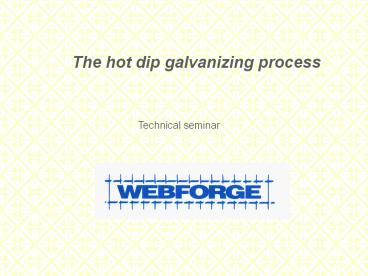The hot dip galvanizing process - PowerPoint PPT Presentation
1 / 13
Title:
The hot dip galvanizing process
Description:
Title: No Slide Title Author: John Robinson Last modified by: tammy mackey Created Date: 5/20/2000 1:31:43 AM Document presentation format: On-screen Show – PowerPoint PPT presentation
Number of Views:1833
Avg rating:3.0/5.0
Title: The hot dip galvanizing process
1
The hot dip galvanizing process
Technical seminar
2
The hot dip galvanizing process
- Loading - jigging
- Degreasing
Hot caustic
3
The hot dip galvanizing process
Loading - jigging
The steel items need to be supported during the
hot dip galvanizing process. Can the item be
easily jigged? Will touch marks be a problem?
Solutions and molten zinc must be able to flow
into all sections and drain off all sections.
Steel items must be designed to prevent air,
solutions and molten zinc becoming trapped
Check design for possible problems
4
The hot dip galvanizing process
Degreasing
A hot (90oC) caustic bath is used to remove
- Oil, grease, paint another organic compounds
If these contaminating materials are not removed,
the next stage of the process (pickling) is
affected
Check if any paint is on item - some paints are
not easily removed and may require abrasive
blasting before galvanizing
Some pipes and pipe fittings have a black varnish
coating that cannot be removed in the caustic
bath.
5
The hot dip galvanizing process
Acid pickling
The steel items are immersed in hydrochloric acid
to remove - rust, mill scale and other metal
oxides
The steel surface must be perfectly clean of
these oxides for the molten zinc to react with
the steel
Very heavy rust may not be easily removed by
pickling - badly rusted items should be abrasive
blasted or mechanically cleaned first.
6
The hot dip galvanizing process
Pre-fluxing
Steel items are water rinsed after pickling and
immersed in hot (70-80oC) zinc ammonium chloride
(ZAC) solution.
The ZAC solution conditions the clean steel
surface ready for hot dip galvanizing.
Good pre-treatment good quality galvanizing
7
The hot dip galvanizing process
Quenching
After hot dip galvanized steel item is removed
from the galvanizing bath, it is immediately
quenched in a sodium dichromate solution
The dichromate quenching cools the item so that
it can be quickly handled and passivates the
surface of the galvanized coating to maintain its
bright appearance.
8
The hot dip galvanizing process
Hot dip galvanizing
The steel is immersed in molten zinc (temp 4500C)
The clean steel surface reacts with the molten
zinc to form a zinc-iron alloy which is very
strongly bonded to the surface.
The hot dip galvanized coating forms in 3-5
minutes, depending on the steel thickness.
Free zinc layer
Galvanized coating
Alloy layers
Steel
Micrograph - 100 X
9
The hot dip galvanizing process
Quenching
After hot dip galvanized steel item is removed
from the galvanizing bath, it is immediately
quenched in a sodium dichromate solution
The dichromate quenching cools the item so that
it can be quickly handled and conditions the
surface of the galvanized coating to maintain its
bright appearance.
Dichromate quenching will reduce white rusting
problems. White rust forms when rainwater reacts
with newly galvanized steel to form zinc
hydroxide. Poor storage or HDG steel will also
promote white rust.
10
The hot dip galvanizing process
Characteristics
- Typically 65 - 150 microns thick ( 1 mm 1000
microns) - Zinc iron alloy layers make up 80 - 100 of
the coating. - The zinc-iron alloy layers are harder than 250
grade steel
11
The hot dip galvanizing process
Coating comparisons
Compared to zinc electroplating (ZEP)and
continuous galvanizing (CG), hot dip galvanizing
(HDG) is better because..
- HDG is thicker and will last over 50 years or
more without rusting
- HDG is harder and is 5 times more abrasion
resistant than ZEP and CG
- HDG coats all external and internal surfaces
and edges. All CG coatings have cut, exposed
edges after processing.
12
Coating thickness of coatings on galvanized
products
Z350 Gal. sheet
HDG Heavy
Coating thickness - microns
Electroplating
HDG Light
13
The hot dip galvanizing process
Zinc cost versus surface area versus zinc pickup
Zinc price 2.00/kg
Good design reduces excessive zinc pick-up































